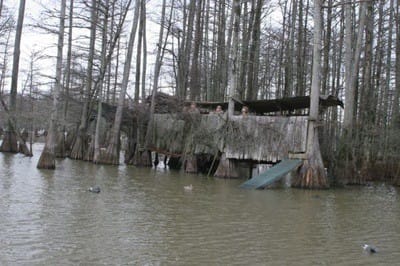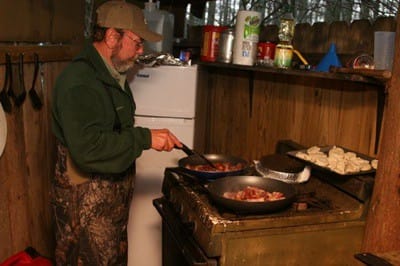
A heap of scrambled eggs was balanced on a plastic fork just inches from my open mouth when Bill Cooksey interrupted.
“Straight out. Coming in,” hissed Cooksey. As the media relations director for Avery Outdoors, he has the luxury of spending countless days in a duck blind each season. As a result, he is acutely aware of what’s going on not only in the blind, but in the sky in front of the blind. While the rest of us were scarfing down a hot breakfast, Cooksey was constantly scanning the air over the decoys, calling out passing ducks and in this case, incoming birds.
It was 8 in the morning and the action had slowed to a mere trickle, so Mike Boyd fired up the propane stove and started on breakfast. Six of us were sitting in a palatial duck blind deep in a cypress break on Beaver Dam Lake. The blind, built on poles and covered with weather-beaten boards and graying cypress limbs, was as much a small house as a blind.
At Cooksey’s words, I froze. Should I finish my bite before I reached for my Remington or toss my plate on the floor and grab the gun? The gadwalls, however, saw something they didn’t like and flared just out of range.
“That’s alright. There’s more where they came from,” said Boyd, a full-time guide who owns a small slice of this fabled lake.
There were plenty more, of course. How could there not be in a place immortalized by one of the most famous writers in hunting history? Beaver Dam was one of the favorite hunting grounds of Nash Buckingham, a regular contributor to Field & Stream in the late 1800s and the early 1900s and author of such books as De Shootinest Gent’man and Game Bag—Tales Of Hunting And Fishing. He immortalized Beaver Dam in the pages of his works and wowed readers with stories of incredible hunts on this Mississippi River oxbow lake.
It’s no wonder Nash and a cadre of sophisticated sportsmen fell in love with this place. At the time, bobwhite quail were abundant on the nearby farms and ducks filled the skies over the lake and the Mississippi River. Those days are gone, at least in many ways. The quail have all but disappeared, and Boyd relies on a metal boat powered by a Go Devil outboard to reach his massive blinds built on pressure-treated posts deep in the flooded cypress trees. The ducks, however, still pour into Beaver Dam, and they are just as challenging to decoy as they have ever been.

“We have good seasons and fair seasons, but overall, I’d say the duck hunting as good as I’ve seen it in all the years I’ve been hunting ducks,” he said.
Limits can come quick as flocks of ducks tumble through the veil of cypress limbs that surround the open holes in front of Boyd’s blinds. He and his clients kill gadwalls mostly, but mallards can show up at any time, and wigeon and green-wing teal make up the bulk of the rest of the ducks. Surprisingly, Boyd’s clients kill few wood ducks, despite the endless amount of flooded cypress trees that make Beaver Dam so captivating.
“Buckingham and the rest of his club actually hunted woodies in August in September. That’s why they called them ‘summer ducks’,” he explained. “I’ve been hunting here since 1963 and I still haven’t figured out the wood ducks.”
He has, however, figured out the rest of the ducks that winter here. But sometimes, even when you have them figured out, you aren’t going to burn through boxes of shells. After we finished our breakfast, we managed to scratch down a few more gadwalls, but the weather just wasn’t what we wanted, explained Boyd. A bright sun is best in deep timber—we hunted under heavy skies and a light rain.
Buckingham certainly didn’t have banner days every time he watched the sun rise over Beaver Dam, and the action was slow, at least by Boyd’s standards, on this day, too. We shot ducks, enough to keep my eyes focused on the sky, and we saw thousands more throughout the days I spent in Boyd’s blind. Mostly, however, I was thrilled, honored even, to be hunting in the same cypress breaks where Buckingham hunted 100 years ago.
Contact Mike Boyd at www.beaverdamducks.com.







